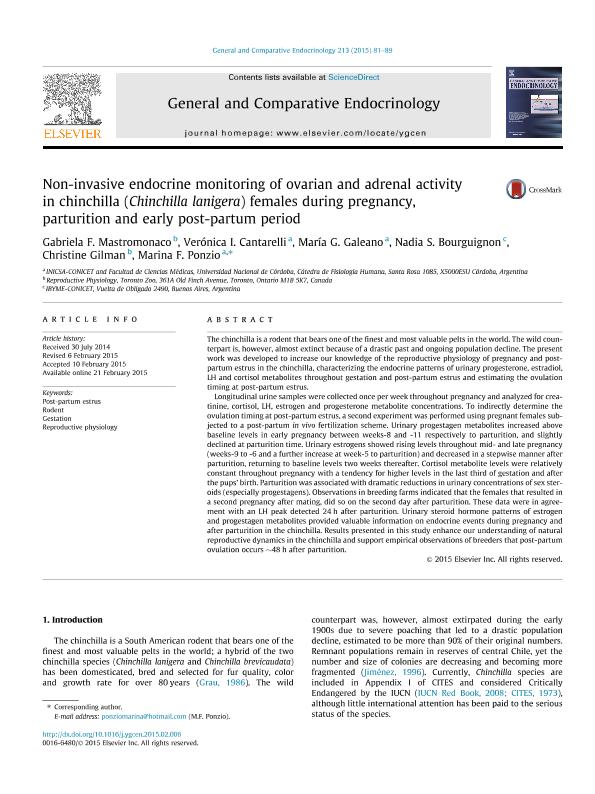Artículo
Non-invasive endocrine monitoring of ovarian and adrenal activity in chinchilla (Chinchilla lanigera) females during pregnancy, parturition and early post-partum period
Mastromonaco, Gabriela F.; Cantarelli, Verónica Inés; Galeano, Maria Georgina; Bourguignon, Nadia ; Gilman, Christine; Ponzio, Marina Flavia
; Gilman, Christine; Ponzio, Marina Flavia
 ; Gilman, Christine; Ponzio, Marina Flavia
; Gilman, Christine; Ponzio, Marina Flavia
Fecha de publicación:
01/03/2015
Editorial:
Elsevier
Revista:
General and Comparative Endocrinology
ISSN:
0016-6480
e-ISSN:
1095-6840
Idioma:
Inglés
Tipo de recurso:
Artículo publicado
Clasificación temática:
Resumen
The chinchilla is a rodent that bears one of the finest and most valuable pelts in the world. The wild counterpart is, however, almost extinct because of a drastic past and ongoing population decline. The present work was developed to increase our knowledge of the reproductive physiology of pregnancy and post-partum estrus in the chinchilla, characterizing the endocrine patterns of urinary progesterone, estradiol, LH and cortisol metabolites throughout gestation and post-partum estrus and estimating the ovulation timing at post-partum estrus.Longitudinal urine samples were collected once per week throughout pregnancy and analyzed for creatinine, cortisol, LH, estrogen and progesterone metabolite concentrations. To indirectly determine the ovulation timing at post-partum estrus, a second experiment was performed using pregnant females subjected to a post-partum in vivo fertilization scheme. Urinary progestagen metabolites increased above baseline levels in early pregnancy between weeks-8 and -11 respectively to parturition, and slightly declined at parturition time. Urinary estrogens showed rising levels throughout mid- and late pregnancy (weeks-9 to -6 and a further increase at week-5 to parturition) and decreased in a stepwise manner after parturition, returning to baseline levels two weeks thereafter. Cortisol metabolite levels were relatively constant throughout pregnancy with a tendency for higher levels in the last third of gestation and after the pups´ birth. Parturition was associated with dramatic reductions in urinary concentrations of sex steroids (especially progestagens). Observations in breeding farms indicated that the females that resulted in a second pregnancy after mating, did so on the second day after parturition. These data were in agreement with an LH peak detected 24. h after parturition. Urinary steroid hormone patterns of estrogen and progestagen metabolites provided valuable information on endocrine events during pregnancy and after parturition in the chinchilla. Results presented in this study enhance our understanding of natural reproductive dynamics in the chinchilla and support empirical observations of breeders that post-partum ovulation occurs ~48. h after parturition.
Palabras clave:
Gestation
,
Post-Partum Estrus
,
Reproductive Physiology
,
Rodent
Archivos asociados
Licencia
Identificadores
Colecciones
Articulos(IBYME)
Articulos de INST.DE BIOLOGIA Y MEDICINA EXPERIMENTAL (I)
Articulos de INST.DE BIOLOGIA Y MEDICINA EXPERIMENTAL (I)
Citación
Mastromonaco, Gabriela F.; Cantarelli, Verónica Inés; Galeano, Maria Georgina; Bourguignon, Nadia; Gilman, Christine; et al.; Non-invasive endocrine monitoring of ovarian and adrenal activity in chinchilla (Chinchilla lanigera) females during pregnancy, parturition and early post-partum period; Elsevier; General and Comparative Endocrinology; 213; 1-3-2015; 81-89
Compartir
Altmétricas



